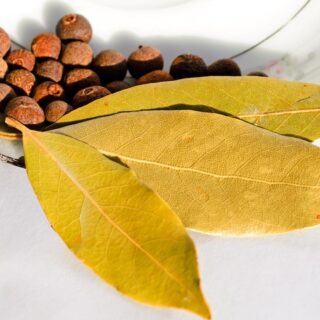All About Bay Leaf | Know Your Spice Bay Leaf (Laurus nobilis L.)
All About Bay Leaf | Know Your Spice Bay Leaf (Laurus nobilis L.) or Laurel Leaf | Health Benefits of Bay Leaves – Bay Leaf or Laurel Leaf are dried leaves or an evergreen shrub or more rarely a tree attaining a height of 15 to 20 mtrs.
The upper surface of the leaf is glabrous and shiny, olive green, and lower surface is dull olive to brown with a prominent rib and veins.
The aroma of the crushed leaves is delicate & fragrant and taste is aromatic and bitter.
The size of the leaves is ranging from 2.5 to 7.5 cms in length and 1.6 to 2.5 cms in breadth. The shape is elliptical and tapering to a point at the base and tip of the leaves.
When European or American recipes call for bay leaves, they’re typically referring to the leaves of a bay laurel tree. In other cuisines, bay leaves may refer to the leaves of a different member of the laurel family.
The Bay Leaf (Laurus nobilis L.) and Tej Patta (Cinnamomum tamala) or Indian Bay Leaves are not the same, however, in India, the term is used interchangeably. However, they do belong to the same family of Lauraceae.
What is the nutrition value & health benefits of Bay Leaf?
Bay leaves are a rich source of vitamin A, vitamin C (ascorbic acid), iron, potassium, calcium, and magnesium.
The fresh leaves and herb parts are superb in folic acid.
Bay leaves have many volatile active components such as a-pinene, ß-pinene, myrcene, limonene, linalool, methyl chavicol, neral, a-terpineol, geranyl acetate, eugenol, and chavicol.
These compounds are known to have been antiseptic, antioxidant, digestive, and thought to have anti-cancer properties.
The essential oil from the leaves (0.8 to 3%) contains mostly 1,8 cineol (50%); furthermore, eugenol, acetyl eugenol, methyl eugenol, α‑ and β‑pinene, phellandrene, linalool, geraniol and terpineol.
What is the Indian name for Bay Leaf?
Indian Bay leaves are known as Tej Patta which translates as ‘pungent leaf’ or Malabar leaf. Despite finding 61 other names for Bay Leaves, I was unable to find an Indian name for Laurel Leaf.
Indian Bay leaves should not to be confused with the European Laurel Bay leaves more commonly used in Mediterranean cuisine!
What is the Bay Leaf history & story?
Bay leaves were considered holy and associated with Apollo in the classic Greek era.
The winners of the famous Olympic Games, held every four years beginning in 776 in Olympia in honour of Zeus, were originally crowned with a wreath of olive twigs, the later use of laurel wreaths is more known today.
The change from olive to laurel was due to the influence of the Pythian Games, which were conducted in honour of Apollo in Delphi (Southern Greece), starting 582.
Within a decade after opening the Pythian Games to all Greeks, two more festivals arose which were, in contrast, held every second year.
Much later, the Roman Emperors made use of the laurel wreath as a symbol of the god Apollo; furthermore, bay leaves were a popular spice in Roman cookery.
What are the uses of Bay Leaf?
The leaves are added to slow-cooked recipes, such as soups, sauces, and stews, and are removed before serving the dish.
They have a floral and herbal scent reminiscent of oregano and thyme and are used more often than any other herb.
The health benefits of the bay leaf and its berries are plentiful. It has astringent, diuretic, and appetite stimulant properties making it useful medically.
Traditionally, bay leaves are picked and dried slowly under the shade away from direct sunlight to retain their volatile essential oils.
Bay leaves are a rather common flavouring in all Western countries; they are used for soups, stews, sauces, pickles and sausages; several fish dishes profit greatly from bay leaves.
In contrast to the majority of leave spices, bay leaves can be cooked for prolonged time without much loss of aroma. Fresh or dried bay leaves frequently show up in the bouquet garni.
Because the leaves do not soften as they cook, bay leaves are added to simmering sauces or included in a braising liquid, and then removed before serving.
What is the taste of Bay Leaf?
If you smell a dried bay leaf, you might not get as much aroma as you would with a pinch of dried basil or thyme. But that doesn’t mean there isn’t flavor there.
When bay leaves are infused into water or broth an almost minty flavour develops, with subtle hints of black pepper and Christmas tree pine.
Bay leaves add a subtle bitterness that keeps heavy soups and stews from being so, well, heavy.
How long does Bay Leaf last?
Fresh bay leaves can be placed in a sealed zip-top bag and refrigerated. Like this they will last for two weeks.
Dried bay leaves can be stored in an airtight container in a cool, dry, and dark place in your pantry; they will last up to two years before losing their aroma.
You can also store the dried bay leaves in the freezer, which will help the bay leaf retain its flavour and floral potency.
How can I dry bay leaves at home?
Line a baking sheet with paper towels and spread bay leaves out. Or lay the bay leaves out singly, without overlapping, and dry on a piece of mesh screen.
Is there a substitute for Bay Leaf?
The following herbs are similar in flavour to dried bay leaves and they may work in your recipe: oregano, basil & thyme. Basil leaves are also used for their bitter and peppery notes.
What can I use Bay Leaf leaves for?
- Bay leaves make a welcome addition to a savory casserole, a braised cut of meat, or a pot of rice, couscous, or risotto.
- Bay leaves work especially well in culinary staples like marinara, béchamel, and curries.
- Enhance flavours of root vegetables, greens, and fresh-caught fish and seafood.
- Scatter bay leaves around your kitchen to ward off common pests.
- Bay leaf tea is also considered to be a super health supplement.
What are the health benefits of Bay Leaf?
Health Benefits of Bay leaves or Medical Benefits of Bay Leaf
- Health benefits of bay leaves in cancer treatment – A new study has found that extract from the bay leaf plant is a natural option that might be able to help. The extract may help kill cancer cells by assisting apoptosis, or programmed cell death.
- Health benefits of bay leaves in diabetes – 1-3g of bay leaf extract daily can help lower and manage glucose levels and cholesterol levels in people with diabetes.
- Health benefits of bay leaves against inflammation – Bay leaf extract has healing properties that can reduce inflammation in the wound area.
- Health benefits of bay leaves for brain health – Ancient texts refer to the bay leaf as a treatment for seizures
- Health benefits of bay leaves for digestion – According to a 2019 report published in the Medicinal Plants of South Asia Journal, bay leaves not only add great flavor and taste to the food, but also help to give relief from abdominal pain, gastrointestinal infections, flatulence, bloating, constipation, and diarrhea.
- Health benefits of bay leaves – Bay leaves have strong antibacterial properties – When the essential oil of bay leaves is extracted, it can be mixed into a salve and applied to the chest to help alleviate various respiratory conditions.
- Health benefits of bay leaves for hair health –Anecdotal evidence suggests that bay leaf works wonders to treat dandruff and reduce hair fall problems.
- Health benefits of bay leaves in heart health –Caffeic acid and rutin are both important organic compounds, found in bay leaves, that enhance our heart health.
- Health benefits of bay leaves to reduce stress – Linalool, a compound, present in bay leaves can help lower the level of stress hormones in the body, especially when used in aromatherapy.
Bay Leaves - Bay Leaf Tea | Make Bay Leaves Tea
Ingredients
- 2 Piece Bay leaves
- 2 Cups Water
- 1 Tablespoon Lemon Juice
- 1 Teaspoon Honey Optional
Instructions
- Gather the ingredients for bay leaves tea.
- In a small pot, add the bay leaves and water.
- Cover and boil over high heat for 3 minutes.
- Remove the pot from the heat and let the tea steep for 3 minutes.
- Strain out the bay leaves.
- Add lemon juice & serve
Notes
- Honey is totally optional. Avoid using it if your don't want a sweeter taste.
Tools & Equipment Used For This Recipe
All About Bay Leaf | Know Your Spice Bay Leaf (Laurus nobilis L.) or Laurel Leaf | Health Benefits of Bay Leaf – Bay Leaf or Laurel Leaf are dried leaves or an evergreen shrub or more rarely a tree attaining a height of 15 to 20 mtrs.
The Bay Leaf (Laurus nobilis L.) and Tej Patta (Cinnamomum tamala) or Indian Bay Leaves are not the same, however, in India, the term is used interchangeably. However, they do belong to the same family of Lauraceae.
The upper surface of the leaf is glabrous and shiny, olive green, and lower surface is dull olive to brown with a prominent rib and veins.
The aroma of the crushed leaves is delicate & fragrant and taste is aromatic and bitter.
The size of the leaves is ranging from 2.5 to 7.5 cms in length and 1.6 to 2.5 cms in breadth. The shape is elliptical and tapering to a point at the base and tip of the leaves.
When European or American recipes call for bay leaves, they’re typically referring to the leaves of a bay laurel tree. In other cuisines, bay leaves may refer to the leaves of a different member of the laurel family.
STAY CONNECTED
If you like this article, you can let us know in the comments below or on social media using #gosumitup and tag @gosumitup.
I am always happy to read your feedback and if you liked the dish or if you made the dish. :)
Better still, take a picture and post it on Instagram and tag it as #gosumitup
Connect direct – You can also connect with me directly on my Instagram and Facebook or on Pinterest.
And, keep visiting us for more of such awesomeness. Do bookmark gosumitup.com into your web browser now or simply subscribe to our browser notifications.
This article has been compiled for general information only and should not be used for the diagnosis or treatment of any medical condition/s.
This information is not intended to diagnose, treat, cure, or prevent any disease.
GoSumItUp.com has used all reasonable care in compiling the information but offers no warranty as to its accuracy or its use in any possible form.
Consult a doctor or other health care professional for diagnosis and treatment of any medical condition/s. For more details please refer to our disclosure policy.





